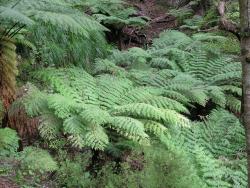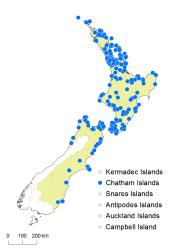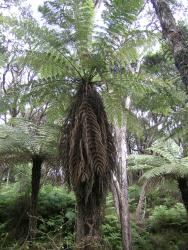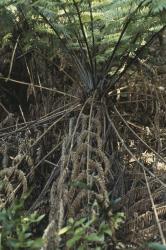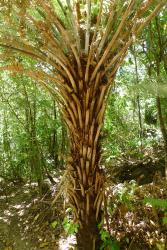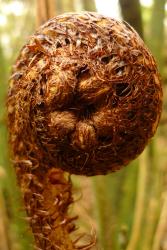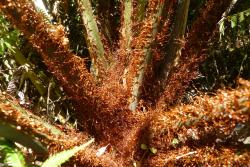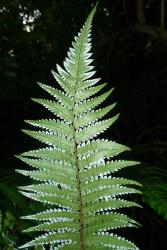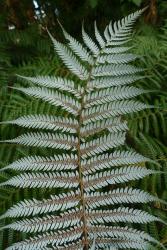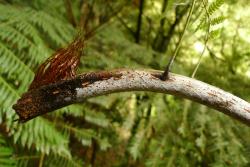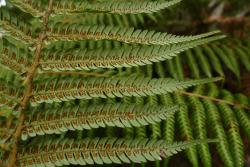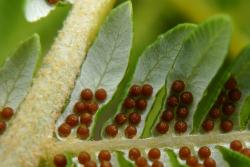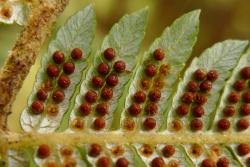- ≡ Polypodium dealbatum G.Forst., Fl. Ins. Austr. 83 (1786)
- = Cyathea tricolor Colenso, Trans. & Proc. New Zealand Inst. 15: 304 (1883)
- ≡ Cyathea dealbata var. tricolor (Colenso) Domin, Biblioth. Bot. 20(85): 27 (1913)
- ≡ Alsophila tricolor (Colenso) R.M.Tryon, Contr. Gray Herb. 200: 37 (1970)
- = Hemitelia falciloba Colenso, Trans. & Proc. New Zealand Inst. 24: 394 (1892)
- ≡ Cyathea falciloba (Colenso) Domin, Pteridophyta 264 (1929)
Rhizomes very rarely prostrate, usually erect, forming a woody trunk up to c. 12 m tall, 160–450 mm in diameter, covered in light brown or white projecting stipe bases; bearing scales near the apex. Rhizome scales marginate, acicular, lacking dark-coloured setae, chestnut-brown, shining. Fronds 2000–4000 mm long, held horizontally; dead fronds often persistent in immature plants, rarely so in mature plants. Stipes 30–900 mm long, 15–40 mm wide and 15–40 mm deep at the base, pale brown or whitish, tuberculate and slightly to moderately rough; scales at base of stipe chestnut-brown, shining, twisted, up to 70 mm long and 3 mm wide, becoming more scattered distally. Laminae deeply 2-pinnate-pinnatifid to 2-pinnate-pinnatisect, ovate or elliptic or obovate, 1500–3350 mm long, 600–1150 mm wide, herbaceous or coriaceous; adaxial surface dark green and slightly glossy; abaxial surface often green in young plants but becoming white or glaucous or occasionally grey- or blue-green in older plants; adaxial surfaces of rachis and pinna midribs sparsely covered with colourless or pale brown curly hairs up to c. 1 mm long, but the lamina more or less glabrous; abaxial surfaces bearing abundant curly hairs; abaxial surface of costae bearing occasional pale brown ovate scales with a dark terminal seta c. 1 mm long; junctions of the pinnae with the rachis sometimes bearing larger ovate scales up to c. 3 mm long and 1 mm wide with dark terminal and lateral setae arising from the surface of the scales; rachis pale brown or whitish. Primary pinnae in 20–30 pairs, either ovate, narrowly ovate, narrowly triangular or narrowly elliptic; the longest at or above the middle, 290–650 mm long, 135–240 mm wide, short-stalked, gradually decreasing proximally to a much reduced basal pair. Secondary pinnae narrowly ovate or narrowly triangular or narrowly elliptic, the longest 70–145 mm long, 13–30 mm wide, short-stalked or sessile, either deeply divided almost to the base, or completely divided into tertiary segments. Longest tertiary segments 7–18 mm long, 2–4 mm wide, adnate or decurrent; apices acute; margins entire or shallowly serrate. Sori 0.5–0.8 mm in diameter; paraphyses shorter than sporangia; indusia covering sori before maturity, opening to form a deep cup with a smooth rim at maturity, often later breaking apart.
Cyathea dealbata is usually immediately recognisable by the white colour of the undersurface of the fronds. Aberrant specimens, and very young plants, with grey-green, blue-green or green undersurfaces can be identified by the abundant curly hairs. The indusia are also distinctive at maturity when they form a deep cup-shape, but are best seen at senescence when the sporangia have been shed.
Cyathea dealbata is morphologically very similar to C. milnei. The two taxa are characterised by abundant crisped or curled hairs on both surfaces of the laminae, and by indusia which open at maturity to form a deep cup that later breaks apart or spreads out to form a bowl shape. No other species in New Zealand have indusia of this type or such a preponderance of curled hairs. Cyathea milnei is distinguished by the green colour of the abaxial lamina surface compared to the distinctive white colour of most populations of C. dealbata, although there are several populations in northern New Zealand that have grey- or blue-green abaxial surfaces. Cyathea milnei also tends to have more persistent dead fronds on the trunks of mature plants, pale brown rather than white stipes and rachises, more conspicuously tuberculate stipe bases, proportionally fewer hairs and more scales on the abaxial costae, slightly larger sori (0.6–0.8 mm, cf. c. 0.5 mm wide), and more fragile indusia that break up easily. The status of the two species has been discussed by Brownsey & Perrie (2015a). They are very closely related, but are retained here as species in the absence of any definitive evidence to the contrary.
North Island: Northland, Auckland, Volcanic Plateau, Gisborne, Taranaki, Southern North Island.
South Island: Western Nelson, Sounds-Nelson, Marlborough, Canterbury, Otago.
Three Kings Islands, Chatham Islands.
Altitudinal range: 0–900 m.
Cyathea dealbata occurs on the Three Kings Islands and throughout coastal and lowland areas of the North Island. In the South Island it occurs in coastal and lowland areas from Nelson and Marlborough south to Punakaiki on the west coast, and to just south of Dunedin on the east coast. It is also present on the Chatham Islands. In the North Island it grows from near sea-level to about 650 m in the Kaweka Ranges and 800 m on the Waimarino Plains. In the South Island it is mostly found in coastal and lowland areas but extends locally into montane forest, reaching 900 m at Jordan Stream in the Inland Kaikoura Ranges.
Cyathea dealbata occurs as a sub-canopy species under kauri, podocarp, beech and broadleaved forest, and in kānuka and mānuka scrub, usually in drier areas. It is occasionally found on bush margins and in more open areas, and has been recorded from amongst rushes in a dune slack.
n = 69 (Brownlie 1958).
There are three syntype specimens of Hemitelia falciloba Colenso in WELT (P002483–4, P003305), and two more at AK (136265, 136267). Allan (1961, p. 41) lectotypified one of the specimens in WELT (P003305) by describing uniquely the material (now on two sheets) as comprising "four partial pinnae (2 sterile, 2 fertile)".
Allan (1961, p. 40) also lectotypified Cyathea tricolor Colenso but the specimen in WELT is now missing, presumed lost, and a replacement lectotype at K was selected from syntypes in AK, K and WELT by Brownsey & Perrie (2015b).
Rawlings (1969) reported an unusual form of Cyathea dealbata from Warawara Forest with prostrate rhizomes. Similar plants were reported by Bryony Macmillan from Warkworth (CHR 199046) and by Peter de Lange from Te Paki at Unuwhao Bush (AK 223017–9, 222931), near North Cape (AK 322831–3) and Radar Bush (WELT P027464). The fronds collected by Rawlings were said to be sterile and less white than usual in this species, and as "dirty-grey to glaucescent" by de Lange. Some other populations in northern New Zealand, from Raglan, Kāwhia and Waihi to North Cape, and from Coppermine Island, Rabbit Island, Goat Island and the Three Kings Islands, have blue-grey, grey-green or almost green abaxial surfaces but do not appear to differ in any other character from populations with white undersurfaces. Colenso’s C. tricolor, described from the Seventy Mile Bush between Norsewood and Dannevirke, was also noted for its "bluish tint", as well as for its "shining dark green upper foliage" and "general and regular drooping appearance". These plants appear to be at one end of clinal variation in C. dealbata and are not recognised taxonomically here.
Kirk (1873) recorded a specimen of C. dealbata with a branching trunk and double crown, but suggested that it might have arisen as a result of damage to the growing point. He noted three other examples that he had seen with similar branching trunks.



